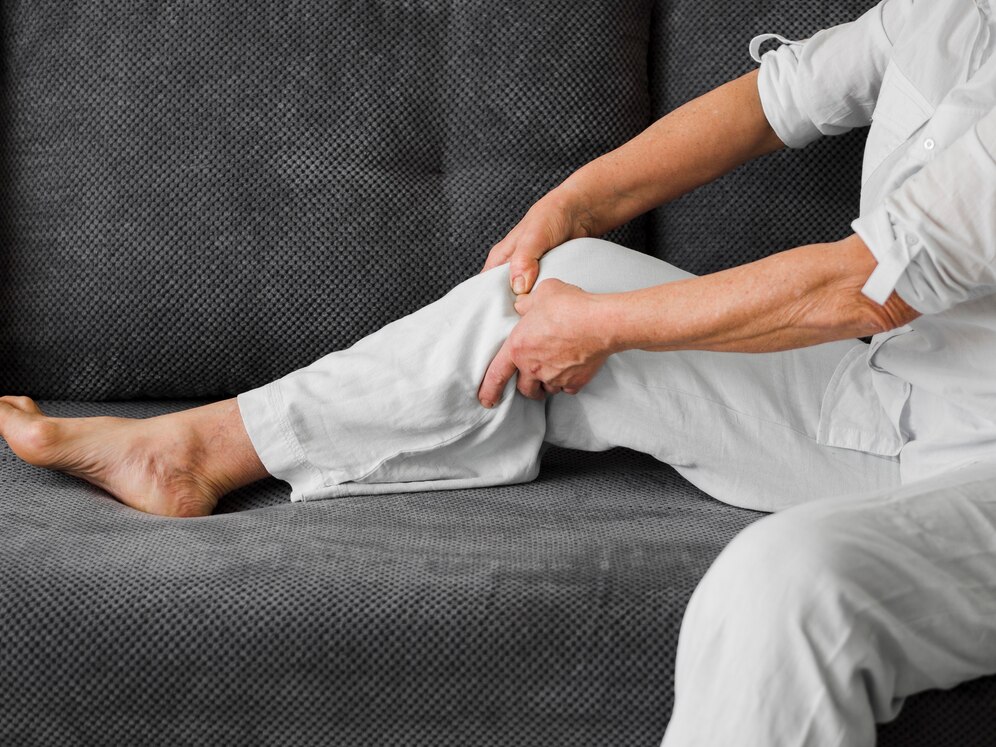Knee pain is a common problem that affects people of all ages. But for many, the pain becomes especially troublesome at night. You may go through your day managing discomfort, only to find the pain worsening when you try to rest. Nighttime knee pain not only disrupts sleep but can also impact recovery and overall quality of life. Understanding why it happens and how to manage it is the first step toward relief.
Common Reasons Knee Pain Feels Worse at Night:
1. Reduced Movement and Blood Flow
During the day, walking or moving around keeps blood circulation steady and joints lubricated. At night, long hours of stillness can lead to stiffness, making pain more noticeable.
2. Sleeping Positions
Certain positions put extra pressure on your knees. For example, side-sleeping with knees pressed together can worsen pain, while poor mattress support can strain your joints further.
3. Inflammation Cycles
Your body’s natural inflammatory process tends to peak at night. Conditions like arthritis, bursitis, or tendonitis may feel more intense during these hours.
4. Old Injuries or Strain
Old knee injuries, ligament tears, or meniscus damage can flare up when the joint is inactive for too long.
5. Stress and Sensitivity
When you’re busy during the day, your mind is distracted. At night, with fewer distractions, you may become more aware of the pain.
What You Can Do for Relief from Knee Pain:
Knee pain is one of the most common joint problems people experience, affecting everyone from athletes to older adults. It can stem from injuries, arthritis, overuse, or simple wear and tear. While knee pain can be frustrating and limit your daily activities, there are several practical steps you can take to find relief and improve your mobility.
Home Remedies for Knee Pain Relief
1. Rest and Protect the Knee
Avoid activities that worsen the pain. Giving your knee enough rest allows strained muscles, ligaments, or tendons to heal.
2. Cold and Heat Therapy
- Ice packs reduce swelling and numb sharp pain.
- Warm compresses relax stiff joints and improve blood circulation.
Alternate between the two depending on your condition.
3. Gentle Exercises and Stretches
Low-impact exercises like swimming, cycling, or yoga strengthen the muscles around the knee, providing better support. Stretching helps maintain flexibility and reduces stiffness.
4. Maintain a Healthy Weight
Excess weight puts added stress on your knees. Even a small amount of weight loss can significantly reduce pain and pressure on the joints.
5. Supportive Footwear
Wearing cushioned, well-fitted shoes helps maintain proper alignment and reduces strain on your knees.
Medical Options for Knee Pain Relief
1. Physical Therapy
A physiotherapist can guide you with strengthening and balance exercises tailored to your condition.
2. Medications
Over-the-counter anti-inflammatory drugs or prescribed medication can help manage pain and swelling.
3. Injections
Corticosteroid or hyaluronic acid injections may be recommended in certain cases for longer-term relief.
4. Surgery
For severe damage or advanced arthritis, procedures like arthroscopy, partial, or total knee replacement might be considered.
Lifestyle Tips for Long-Term Relief
- Stay active, but choose low-impact activities.
- Avoid sitting or standing in one position for too long.
- Practice good posture while sitting and walking.
- Add joint-friendly foods rich in omega-3s, calcium, and vitamin D to your diet.
Conclusion
Knee pain can feel frustrating, especially when it robs you of rest. But with the right adjustments—such as supportive sleep positions, gentle exercises, and targeted therapies—you can find relief and improve sleep quality. If your pain persists, consulting an orthopedic specialist is the best way to identify the underlying cause and get long-term solutions.

